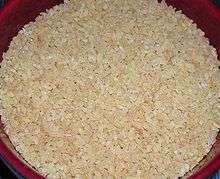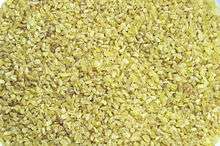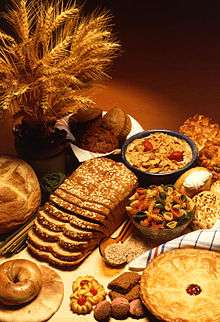Bulgur
Bulgur (from Turkish: bulgur, lit. 'groats';[1] also burghul, from Arabic: برغل, romanized: burġul, lit. 'groats'[2]) is a cereal food made from the cracked parboiled groats of several different wheat species, most often from durum wheat. It originates in Middle Eastern cuisine.

Characteristics
| Nutritional value per 100 g (3.5 oz) | |
|---|---|
| Energy | 83 kcal (350 kJ) |
18.58 g | |
| Sugars | 0.10 g |
| Dietary fiber | 4.5 g |
0.24 g | |
3.08 g | |
| Vitamins | Quantity %DV† |
| Vitamin A equiv. | 0% 0.0 μg |
| Vitamin A | 1 IU |
| Thiamine (B1) | 5% 0.057 mg |
| Riboflavin (B2) | 2% 0.028 mg |
| Niacin (B3) | 7% 1.000 mg |
| Vitamin B6 | 6% 0.083 mg |
| Folate (B9) | 5% 18 μg |
| Vitamin C | 0% 0.0 mg |
| Vitamin E | 0% 0.01 mg |
| Minerals | Quantity %DV† |
| Calcium | 1% 10 mg |
| Iron | 7% 0.96 mg |
| Magnesium | 9% 32 mg |
| Phosphorus | 6% 40 mg |
| Potassium | 1% 68 mg |
| Sodium | 0% 5 mg |
| Zinc | 6% 0.57 mg |
| Other constituents | Quantity |
| Water | 78 g |
| |
| †Percentages are roughly approximated using US recommendations for adults. Source: USDA Nutrient Database | |
Bulgur is sometimes confused with cracked wheat, which is crushed wheat grain that, unlike bulgur, has not been parboiled.[3] Bulgur is a common ingredient in cuisines of many countries of the Middle East and Mediterranean Basin.[4][5][6] It has a light, nutty flavor.[7]
Bulgur is available in a range of grinds, typically fine, medium, coarse and extra coarse. The highest quality bulgur has particle sizes that are uniform.
Bulgur is recognized as a whole grain by the United States Department of Agriculture.[8]
Culinary uses

Bulgur does not require cooking, although it can be included in cooked dishes; soaking in water is all that is needed.[9]
Coarse bulgur is used to make pottages,[10] while the medium and fine grains are used for breakfast cereals,[11] salads such as kısır, pilavs, breads,[12] and in dessert puddings such as kheer.[13][14] Bulgur porridge is similar to frumenty, a cracked wheat porridge that was a staple of medieval cuisine.[15][16]
In breads, it adds a whole-grain component. It is a main ingredient in kibbeh and, soaked but not cooked, in tabbouleh salad. It is often used where rice or couscous could be used. In Indian and Pakistani cuisine, bulgur is often used as a cereal to make a porridge with milk and sugar, or a savory porridge with vegetables and spices. It can be used to accompany other dishes in the same way as pasta or rice; it may be mistaken for rice because it has a similar appearance, although the texture is different.
Armenians prepare bulgur as a pilaf in chicken stock, with or without sauteed noodles, or cooked with tomatoes, onions, herbs and red pepper. The fine grind is used for making eech, a bulgur salad similar to tabbouleh, prepared with tomato paste, fresh tomatoes, cucumbers, parsley, olive oil, and other salad ingredients to personal taste. Pomegranate molasses, which is sour and sweet, is commonly used instead of lemon juice to add tartness. A variety of mezes and main dishes are prepared.
In Cyprus, it is known as "πουρκούρι" and is used to make "κούπες" (also known as bulgur köftesi in Cypriot Turkish), a variety of kibbeh. Its crust is usually made of bulgur wheat, flour, oil, salt and egg, then filled with ground meat (beef and/or pork), onions, parsley and spices. There is also vegetarian "κούπες" which substitutes the ground meat with chopped mushrooms.
The Saudi Arabian version of bulgur, popular in Nejd and Al-Hasa, is known as jarish.[17]
See also
References
- "Bulgur | Definition of Bulgur by Merriam-Webster". Merriam-webster.com. Retrieved 2015-12-25.
- "Burghul | Define Burghul at Dictionary.com". Dictionary.reference.com. Retrieved 2014-03-20.
- Celine Steen; Tamasin Noyes (15 November 2015). The Great Vegan Grains Book: Celebrate Whole Grains with More than 100 Delicious Plant-Based Recipes * Includes Soy-Free and Gluten-Free Recipes!. Fair Winds Press. p. 11. ISBN 978-1-62788-826-4.
- Irina Petrosian; David Underwood (2006). Armenian Food: Fact, Fiction & Folklore. Lulu.com. p. 58. ISBN 978-1-4116-9865-9.
- LeeAnne Gelletly (17 November 2014). The Kurds. Mason Crest. p. 83. ISBN 978-1-63355-946-2.
- Ken Albala (25 May 2011). Food Cultures of the World Encyclopedia [4 volumes]: [Four Volumes]. ABC-CLIO. p. 261. ISBN 978-0-313-37627-6.
- Victoria Wise (3 December 2004). The Pressure Cooker Gourmet: 225 Recipes for Great-Tasting, Long-Simmered Flavors in Just Minutes. Harvard Common Press. p. 230. ISBN 978-1-55832-201-1.
- Jacqueline B. Marcus (15 April 2013). Culinary Nutrition: The Science and Practice of Healthy Cooking. Academic Press. p. 561,300. ISBN 978-0-12-391883-3.
- Joe Yonan (15 July 2014). "Weeknight Vegetarian: Don't cook these grains. Soak them". The Washington Post. Retrieved 12 October 2018.
- Shulman, Martha Rose. "Winter Tomato Soup With Bulgur Recipe". NYT Cooking. Retrieved 2018-08-30.
- "Breakfast Bulgur Porridge". Martha Stewart. 2011-01-03. Retrieved 2018-08-30.
- Shulman, Martha Rose. "Whole Wheat Irish Soda Bread With Bulgur Recipe". NYT Cooking. Retrieved 2018-08-30.
- Salloum, Habeeb (2012-02-28). The Arabian Nights Cookbook: From Lamb Kebabs to Baba Ghanouj, Delicious Homestyle Arabian Cooking. Tuttle Publishing. ISBN 978-1-4629-0524-9.
- "Recipe: Bulgur pudding with fruit, nuts and honey". latimes.com. Retrieved 2018-08-30.
- Rogosa, Eli (2016-07-01). Restoring Heritage Grains: The Culture, Biodiversity, Resilience, and Cuisine of Ancient Wheats. Chelsea Green Publishing. ISBN 978-1-60358-671-9.
- Diehl, Daniel; Donnelly, Mark P. (2011-04-13). Medieval Celebrations: Your Guide to Planning and Hosting Spectacular Feasts, Parties, Weddings, and Renaissance Fairs. Stackpole Books. ISBN 978-0-8117-4430-0.
- "Food from Saudi Arabia". Archived from the original on 2015-01-07. Retrieved 2011-10-02.
| Wikimedia Commons has media related to Bulgur. |
